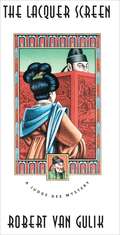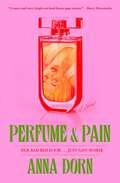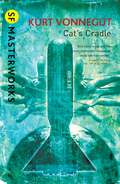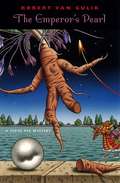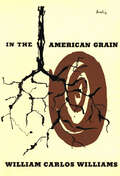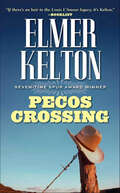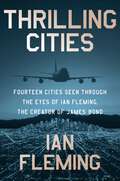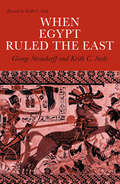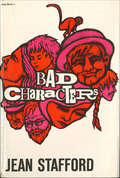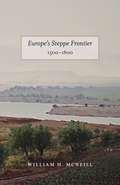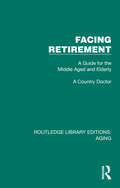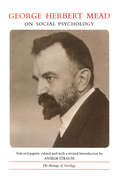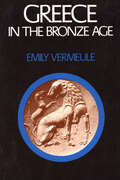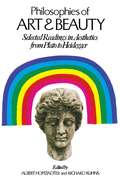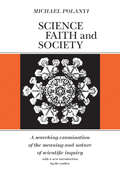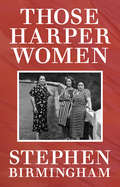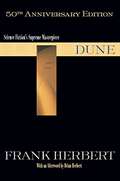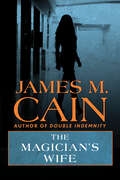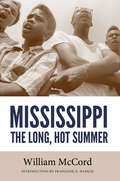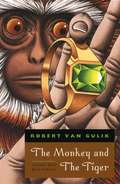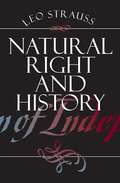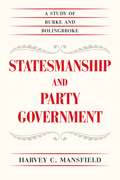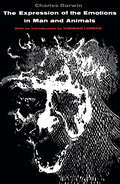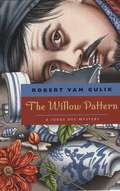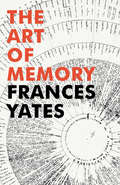- Table View
- List View
The Lacquer Screen: A Judge Dee Mystery (The Judge Dee Mysteries)
by Robert van GulikEarly in his career, Judge Dee visits a senior magistrate who shows him a beautiful lacquer screen on which a scene of lovers has been mysteriously altered to show the man stabbing his lover. The magistrate fears he is losing his mind and will murder his own wife. Meanwhile, a banker has inexplicably killed himself, and a lovely lady has allowed Dee's lieutenant, Chiao Tai, to believe she is a courtesan. Dee and Chiao Tai go incognito among a gang of robbers to solve this mystery, and find the leader of the robbers is more honorable than the magistrate. "One of the most satisfyingly devious of the Judge Dee novels, with unusual historical richness in its portrayal of the China of the T'ang dynasty."-—New York Times Book Review "Even Judge Dee is baffled by Robert van Gulik's new mysteries in The Lacquer Screen. Disguised as a petty crook, he spends a couple of precarious days in the headquarters of the underworld, hobnobbing with the robber king. Dee's lively thieving friends furnish some vital clues to this strange and fascinating jigsaw."-—The Spectator "So scrupulously in the classic Chinese manner yet so nicely equipped with everything to satisfy the modern reader."-—New York Times Robert Van Gulik (1910-67) was a Dutch diplomat and an authority on Chinese history and culture. He drew his plots from the whole body of Chinese literature, especially from the popular detective novels that first appeared in the seventeenth century.
Perfume and Pain: A Novel
by Anna Dorn&“Perceptive and witty—like a Sally Rooney novel set in Southern California.&” —Star Tribune (Minneapolis) &“It&’s this author&’s best work yet. A Sapphic roller-coaster ride.&” —Kirkus Reviews (starred review) A controversial LA author attempts to revive her career and finally find true love in this hilarious nod to 1950s lesbian pulp fiction.Having recently moved both herself and her formidable perfume bottle collection into a tiny bungalow in Los Angeles, mid-list author Astrid Dahl finds herself back in the Zoom writer&’s group she cofounded, Sapphic Scribes, after an incident that leaves her and her career lightly canceled. But she temporarily forgets all that by throwing herself into a few sexy distractions—like Ivy, a grad student researching 1950s lesbian pulp who smells like metallic orchids, or her new neighbor, Penelope, who smells like patchouli. Penelope, a painter living off Urban Outfitters settlement money, immediately ingratiates herself in Astrid&’s life, bonding with her best friends and family, just as Astrid and Ivy begin to date in person. Astrid feels judged and threatened by Penelope, a responsible older vegan, but also finds her irresistibly sexy. When Astrid receives an unexpected call from her agent with the news that actress and influencer Kat Gold wants to adapt her previous novel for TV, Astrid finally has a chance to resurrect her waning career. But the pressure causes Astrid&’s worst vice to rear its head—the Patricia Highsmith, a blend of Adderall, alcohol, and cigarettes—and results in blackouts and a disturbing series of events. Unapologetically feminine yet ribald, steamy yet hilarious, Anna Dorn has crafted an exquisite homage to the lesbian pulp of yore, reclaiming it for our internet and celebrity-obsessed world. With notes of Southern California citrus and sultry smokiness, Perfume and Pain is a satirical romp through Hollywood and lesbian melodrama.
Cat's Cradle (S.F. MASTERWORKS #70)
by Kurt VonnegutOne of America's greatest writers gives us his unique perspective on our fears of nuclear annihilationExperiment.Told with deadpan humour and bitter irony, Kurt Vonnegut's cult tale of global destruction preys on our deepest fears of witnessing Armageddon and, worse still, surviving it.Solution.Dr Felix Hoenikker, one of the founding fathers of the atomic bomb, has left a deadly legacy to the world. For he is the inventor of ice-nine, a lethal chemical capable of freezing the entire planet. The search for its whereabouts leads to Hoenikker's three eccentric children, to a crazed dictator in the Caribbean, to madness. Felix Hoenikker's death-wish comes true when his last, fatal, gift to mankind brings about an end that, for all of us, is nigh.
The Emperor's Pearl: A Judge Dee Mystery (The Judge Dee Mysteries)
by Robert van GulikIt all begins on the night of the Poo-yang dragonboat races in 699 A.D.: a drummer in the leading boat collapses, and the body of a beautiful young woman turns up in a deserted country mansion. There, Judge Dee—tribunal magistrate, inquisitor, and public avenger—steps in to investigate the murders and return order to the Tang Dynasty. In The Emperor’s Pearl, the judge discovers that these two deaths are connected by an ancient tragedy involving a near-legendary treasure stolen from the Imperial Harem one hundred years earlier. The terrifying figure of the White Lady, a river goddess enshrined on a bloodstained altar, looms in the background of the investigation. Clues are few and elusive, but under the expert hand of Robert van Gulik, this mythic jigsaw puzzle assembles itself into a taut mystery. “If you have not yet discovered Judge Dee and his faithful Sgt. Hoong, I envy you that initial pleasure which comes from the discovery of a great detective story. For the magistrate of Poo-yang belongs in that select group of fictional detectives headed by the renowned Sherlock Holmes.”—Robert Kirsch, Los AngelesTimes “The title of this book and the book itself have much in common. Each is a jewel, a rare and precious find.”—AtlantaTimes
In the American Grain (Second Edition)
by William Carlos WilliamsA new edition of William Carlos Williams’ loving and groundbreaking book about American history, with a new introduction by Rick Moody. Although admired by D. H. Lawrence, this modern classic went generally unnoticed during the years after its publication in 1925. Yet it is “a fundamental book, essential if one proposes to come to terms with American literature” (Times Literary Supplement). William Carlos Williams was not a historian, but he was fascinated by the texture of American history. Beginning with Columbus’s discovery of the Indies and moving on through Sir Walter Raleigh, Cotton Mather, Daniel Boone, George Washington, Ben Franklin, Aaron Burr, Edgar Allan Poe, and Abraham Lincoln, Williams found in the fabric of familiar episodes new shades of meaning and configurations of character. He brought a poetic imagination to the task of reconstructing a live tradition for Americans, and what results is one of the finest works of prose to have been penned by any writer of the twentieth century.
Pecos Crossing: Two Complete Novels Of The American West
by Elmer KeltonJohnny Fristo and Speck Quitman, young, hard-working cowboys from Fort Concho, Texas, have worked six months--at $20 a month--on the Devil's River. Their boss, a hawk-faced cow trader named Larramore, reneges on the money he owes the boys and sneaks out of the cow camp and heads for San Angelo.Fristo is tall and thin, his mind a hundred miles away; Quitman is short, bandy-legged, and "bedazzled by the flash of cards and the slosh of whiskey." The two are as different as sun and moon but are inseparable—and now they have a mission: find Larramore and extract the money he owes them.At the Publisher's request, this title is being sold without Digital Rights Management Software (DRM) applied.
Thrilling Cities: Fourteen Cities Seen Through the Eyes of Ian Fleming, the Creator of James Bond
by Ian FlemingA CAPTIVATING JOURNEY AROUND THE WORLD FROM THE CREATOR OF JAMES BONDIan Fleming’s world travels and interests, as well as his journalism and wartime experiences, lent authority to everything he wrote. In 1959, the Sunday Times commissioned Fleming to write a series of dispatches from the world’s most beguiling locales. The result was Thrilling Cities, a masterpiece of well-observed travelogue that stands ably alongside the author’s Bond canon.From Hong Kong to Honolulu, New York to Naples, he left the bright main streets for the back alleys, abandoning tourist sites in favor of underground haunts, and mingling with celebrities, gangsters and geishas. The result is a series of vivid snapshots of a mysterious, vanished world from a twentieth century Western perspective.Just like his most famous fictional creation, Ian Fleming was a well-traveled man of the world who knew where to go to find excitement, adventure…and danger. In Thrilling Cities, he takes us along on a journey of international intrigue worthy of James Bond.
When Egypt Ruled the East
by George Steindorff Keith C. SteeleHere, adequately presented for the first time in English, is the fascinating story of a splendid culture that flourished thirty-five hundred years ago in the empire on the Nile: kings and conquests, gods and heroes, beautiful art, sculpture, poetry, architecture. Significant archeological discoveries are constantly being made in Egypt. In this revision Professor Steele has rewritten whole chapters on the basis of these new finds and offers several new conclusions to age-old problems.
Bad Characters: Stories
by Jean StaffordThis book displays at their height the wit, sensibility and psychological penetration that distinguish Miss Stafford's work. There are nine stories and a novella. They range in mood from the title story, a comic portrait of a resourceful child-criminal named Lottie Jump, to "The End of a Career," an elegiac and ironic tale of the declining years of a great beauty. In "A Reasonable Facsimile" Dr. Bohrmann, a retired professor philosophy, is unexpectedly rescued from an aggressively boring young house guest. "Cops and Robbers" is a chilling story of childhood horror and lovelessness that revolves around a father's trip to the barber with his five-year-old daughter.Several of the stories have as their common setting Miss Stafford's fiction town of Adams, Colorado—including an amusing saga of a girl's frustrated attempts to find a quiet spot to read ("A Reading Problem"), and two stories of failure ("In the Zoo") and success ("The Liberation") in the effort to escape from one's family. "Caveat Emptor" is a satire on the academic life and sub-life at the Alma Hettrick College for Girls; and in "The Captain's Gift" the sheltered and lavender-scented existence of old Mrs. Ramsey is violated by the reality of war.The major piece in Bad Characters is "A Winter's Tale," a haunting and evocative novella set in Heidelberg just before the outbreak of the war. It is dominated by the diabolic character of Frau Professor Persis Galt. This portrait of a former Bostonian who poses as an excessively devout convert is one of Miss Stafford's most brilliant fictional creations.This collection by Jean Stafford will be warmly welcomed by the many and devoted admirers of her novels and stories. To new readers the work of one of the best writers of our time will come as a joyful discovery.
Europe's Steppe Frontier, 1500–1800: 1500-1800
by William H. McNeillIn Europe’s Steppe Frontier, acclaimed historian William H. McNeill analyzes the process whereby the thinly occupied grasslands of southeastern Europe were incorporated into the bodies-social of three great empires: the Ottoman, the Austrian, and the Russian. McNeill benefits from a New World detachment from the bitter nationality quarrels of the late nineteenth and early twentieth century which inspired but also blinded most of the historians of the region. Moreover, the unique institutional adjustments southeastern Europeans made to the frontier challenge cast indirect light upon the peculiarities of the North American frontier experience.
Facing Retirement: A Guide for the Middle Aged and Elderly (Routledge Library Editions: Aging)
by A Country DoctorOriginally published in 1960 and revised in 1964 the blurb for Facing Retirement read:“Mature men and women are not afraid of advancing years. More and more seek to prepare themselves for retirement so that they may then find all the happiness they can.This phase of life is interesting to a widening circle, and in writing this book it was the author’s aim to discuss readably, simply, and from his experience with his patients, most relevant aspects of these later years. It was a pioneer in its approach: any similar books which may follow, if they help to lessen the burden of the elderly and aged which has to be sustained by the younger generations, must be of the highest importance not only to individuals but to the nation.For nearly thirty years the author of this book has had the medical care of over 2,000 people of all ages in a cluster of villages and hamlets at the foot of the Cotswold Hills. He has been chairman or president of the County Association for the Care of old People since its inception in 1952.”Today it can be read and enjoyed in its historical context.
George Herbert Mead on Social Psychology (The Heritage Sociology)
by George HerbertOne of the most brilliantly original of American pragmatists, George Herbert Mead published surprisingly few major papers and not a single book during his lifetime. Yet his influence on American sociology and social psychology since World War II has been exceedingly strong. This volume is a revised and enlarged edition of the book formerly published under the title The Social Psychology of George Herbert Mead. It contains selections from Mead's posthumous books: Mind, Self, and Society; Movements of Thought in the Nineteenth Century; The Philosophy of the Act; and The Philosophy of the Present, together with an incisive, newly revised, introductory essay by Anselm Strauss on the importance of Mead for contemporary social psychology. "Required reading for the social scientist."—Milton L. Barron, Nation
Greece in the Bronze Age
by Emily TownsendFrom the arrival of the first men in Greece to the fall of the Mycenaean palace-town in the thirteenth century B.C., this work captures the essential qualities of each period of pre-classical civilization: the slow development of the Neolithic culture, the rich and original Early Bronze Age, the fruitful yet tragic encounter between Minoans and Mycenaean Empire. The legacy of Mycenaean religion and art is reviewed, including material found in excavated palaces and their stored wealth of frescoes, carved ivories, silver and gold jewelry, vases, and bronze weapons. The author deals with the invasions of Greece, the growth of a Greek language and some of the problems of Linear B, and the impact of Crete and the East upon the mainstream of Greek development.
Philosophies of Art & Beauty: Selected Readings in Aesthetics from Plato to Heidegger
by Albert Hofstadter and Richard KuhnsThis anthology is remarkable not only for the selections themselves, among which the Schelling and the Heidegger essays were translated especially for this volume, but also for the editors' general introduction and the introductory essays for each selection, which make this volume an invaluable aid to the study of the powerful, recurrent ideas concerning art, beauty, critical method, and the nature of representation. Because this collection makes clear the ways in which the philosophy of art relates to and is part of general philosophical positions, it will be an essential sourcebook to students of philosophy, art history, and literary criticism.
Science, Faith and Society: A searching examination of the meaning and nautre of scientific inquiry
by Michael PolanyiIn its concern with science as an essentially human enterprise, Science, Faith and Society makes an original and challenging contribution to the philosophy of science. On its appearance in 1946 the book quickly became the focus of controversy. Polanyi aims to show that science must be understood as a community of inquirers held together by a common faith; science, he argues, is not the use of "scientific method" but rather consists in a discipline imposed by scientists on themselves in the interests of discovering an objective, impersonal truth. That such truth exists and can be found is part of the scientists' faith. Polanyi maintains that both authoritarianism and scepticism, attacking this faith, are attacking science itself.
Those Harper Women
by Stephen BirminghamFour generations of women grapple with the gilded cage of their family dynasty in this #1 New York Times–bestselling author&’s &“big, bustling novel&” (The New York Times). Meredith Harper made millions in rum before Prohibition ruined the market. When he died, he left behind an estate of such vast wealth that his descendants were set for life—but what sort of life would it be? In Those Harper Women, Stephen Birmingham presents a fictional group portrait of women who pass down both fortunes and misfortunes, who want for nothing save happiness. Across generations, the Harper women seek joy, self-fulfillment, or mere escape from the trappings of their privilege. But through trips to Europe and the Caribbean, through marriage and divorce, the women find themselves returning time and again to the looming shadow of Meredith and his money.
Dune: Deluxe Edition (Dune #1)
by Frank Herbert• DUNE: PART TWO • THE MAJOR MOTION PICTUREDirected by Denis Villeneuve, screenplay by Denis Villeneuve and Jon Spaihts, based on the novel Dune by Frank Herbert • Starring Timothée Chalamet, Zendaya, Rebecca Ferguson, Josh Brolin, Austin Butler, Florence Pugh, Dave Bautista, Christopher Walken, Stephen McKinley Henderson, Léa Seydoux, with Stellan Skarsgård, with Charlotte Rampling, and Javier BardemFrank Herbert&’s classic masterpiece—a triumph of the imagination and one of the bestselling science fiction novels of all time.Set on the desert planet Arrakis, Dune is the story of Paul Atreides—who would become known as Muad'Dib—and of a great family's ambition to bring to fruition mankind's most ancient and unattainable dream.A stunning blend of adventure and mysticism, environmentalism and politics, Dune won the first Nebula Award, shared the Hugo Award, and formed the basis of what is undoubtedly the grandest epic in science fiction.
The Magician's Wife
by James M. CainFor the love of a beautiful waitress, a meat salesman will turn butcher in this crime thriller by “one of the greats of American noir” (The Guardian).Clay Lockwood. is a top distributing executive with Grant’s Meats, and the contract with the Portico restaurant chain is only the latest in a long line of boardroom coups. He arrives at the Portico for lunch, and eats his fill of his company’s beef, but leaves with an entirely different hunger gnawing at his gut—a volcanic passion that will tear him apart. Lockwood is mesmerized by hostess Sally Alexis, a magician’s wife. She rebuffs his first pass, but calls him up later…. Although Sally’s marriage is miserable, she won’t leave her husband in order to secure an inheritance for her little boy. And as the lovers get closer, Lockwood becomes an amateur illusionist himself, focusing on one very particular deadly trick—how to make a magician disappear.“James M. Cain is one novelist who has something to teach just about any writer, and delight just about any reader.” —Anne Rice, #1 New York Times–bestselling author of Interview with a Vampire
Mississippi: The Long, Hot Summer (Civil Rights in Mississippi Series)
by William McCordIn 1964, sociologist William McCord, long interested in movements for social change in the United States, began a study of Mississippi's Freedom Summer. Stanford University, where McCord taught, had been the site of recruiting efforts for student volunteers for the Freedom Summer project by such activists as Robert Moses and Allard Lowenstein. Described by his wife as “an old-fashioned liberal,” McCord believed that he should both examine and participate in events in Mississippi. He accompanied student workers and black Mississippians to courthouses and Freedom Houses, and he attracted police attention as he studied the mechanisms of white supremacy and the black nonviolent campaign against racial segregation. Published in 1965 by W. W. Norton, his book, Mississippi: The Long, Hot Summer, is one of the first examinations of the events of 1964 by a scholar. It provides a compelling, detailed account of Mississippi people and places, including the thousands of student workers who found in the state both opportunities and severe challenges. McCord's work sought to communicate to a broad audience the depth of repression in Mississippi. Here was evidence of the need for federal action to address what he recognized as both national and southern failures to secure civil rights for black Americans. His field work and activism in Mississippi offered a perspective that few other academics or other white Americans had shared. Historian Françoise N. Hamlin provides a substantial introduction that sets McCord's work within the context of other narratives of Freedom Summer and explores McCord's broader career that combined distinguished scholarship with social activism.
The Monkey and The Tiger: Judge Dee Mysteries (The Judge Dee Mysteries)
by Robert van GulikThe Monkey and The Tiger includes two detective stories, "The Morning of the Monkey" and "The Night of the Tiger." In the first, a gibbon drops an emerald in the open gallery of Dee's official residence, leading the judge to discover a strangely mutilated body in the woods—and how it got there. In the second, Dee is traveling to the imperial capital to assume a new position when he is separated from his escort by a flood. Marooned in a large country house surrounded by fierce bandits, Dee confronts an apparition that helps him solve a mystery.
Natural Right and History: Lectures And Essays By Leo Strauss, 1937-1946 (Walgreen Foundation Lectures)
by Leo StraussIn this classic work, Leo Strauss examines the problem of natural right and argues that there is a firm foundation in reality for the distinction between right and wrong in ethics and politics. On the centenary of Strauss's birth, and the fiftieth anniversary of the Walgreen Lectures which spawned the work, Natural Right and History remains as controversial and essential as ever. "Strauss . . . makes a significant contribution towards an understanding of the intellectual crisis in which we find ourselves . . . [and] brings to his task an admirable scholarship and a brilliant, incisive mind."—John H. Hallowell, American Political Science Review Leo Strauss (1899-1973) was the Robert Maynard Hutchins Distinguished Service Professor Emeritus in Political Science at the University of Chicago.
Statesmanship and Party Government: A Study of Burke and Bolingbroke
by Harvey C. MansfieldIn this incisive look at early modern views of party politics, Harvey C. Mansfield examines the pamphlet war between Edmund Burke and the followers of Henry St. John, First Viscount Bolingbroke during the mid-eighteenth century. In response to works by Bolingbroke published posthumously, Burke created his most eloquent advocacy of the party system. Taking an interdisciplinary approach to the material, Mansfield shows that present-day parties must be understood in the light of the history of party government. The complicated organization and the public actions of modern parties are the result, he contends, and not the cause of a great change in opinion about parties. Mansfield points out that while parties have always existed, the party government that we know today is possible only because parties are now considered respectable. In Burke’s day, however, they were thought by detractors to be a cancer in a free polity. Even many supporters of the parties viewed them as a dangerous instrument, only to be used cautiously by statesmen in dire times. Burke, however, was an early champion of the party system in Britain and made his arguments with a clear-eyed realism. In Statesmanship and Party Government, Mansfield provides a skillful evaluation of Burke’s writings and sheds light present-day party politics through a profound understanding of the historical background of the their inception.
the Expression of the Emotions in Man and Animals (Cambridge Library Collection - Darwin, Evolution And Genetics Ser.)
by Charles DarwinDarwin's work of 1872 still provides the point of departure for research in the theory of emotion and expression. Although he lacked the modern research tool of cybernetics, his basic methods have not been improved upon: the study of infants, of the insane, of paintings and sculpture, of some of the commoner animals; the use of photographs of expression submitted to different judges; and the comparative study of expression among different peoples. This new edition will be warmly welcomed by those behavioral scientists who have recently shown an intense interest in the scientific study of expression. Lay readers, too, will be struck by the freshness and directness of this book, which includes, among other data, Darwin's delightfully objective analysis of his own baby's smiles and pouts.
The Willow Pattern: A Judge Dee Mystery (The Judge Dee Mysteries)
by Robert van GulikJudge Dee has been appointed emergency governor of the plague- and drought-ridden Imperial City. As his guards help the city fend off a popular uprising, an aristocrat from one of the oldest families in China suffers an "accident" in a deserted mansion.In The Willow Pattern, the illustrious judge uses his trademark expertise to unravel the mysteries of the nobleman, a shattered vase, and a dead bondmaid. Along the way he encounters a woman who fights with loaded sleeves, a nearly drowned courtesan, and an elaborate trap set for a murderer. Packed with suspense, violence, and romance, The Willow Pattern won’t disappoint Judge Dee’s legions of loyal fans."The China of old, in Mr. van Gulik’s skilled hands, comes vividly alive again."—Allen J. Hubin, New York Times Book Review
The Art of Memory
by Frances A YatesThis unique and brilliant book is a history of human knowledge. Before the invention of printing, a trained memory was of vital importance. Based on a technique of impressing 'places' and 'images' on the mind, the ancient Greeks created an elaborate memory system which in turn was inherited by the Romans and passed into the European tradition, to be revived, in occult form, during the Renaissance. Frances Yates sheds light on Dante’s Divine Comedy, the form of the Shakespearian theatre and the history of ancient architecture; The Art of Memory is an invaluable contribution to aesthetics and psychology, and to the history of philosophy, of science and of literature.
